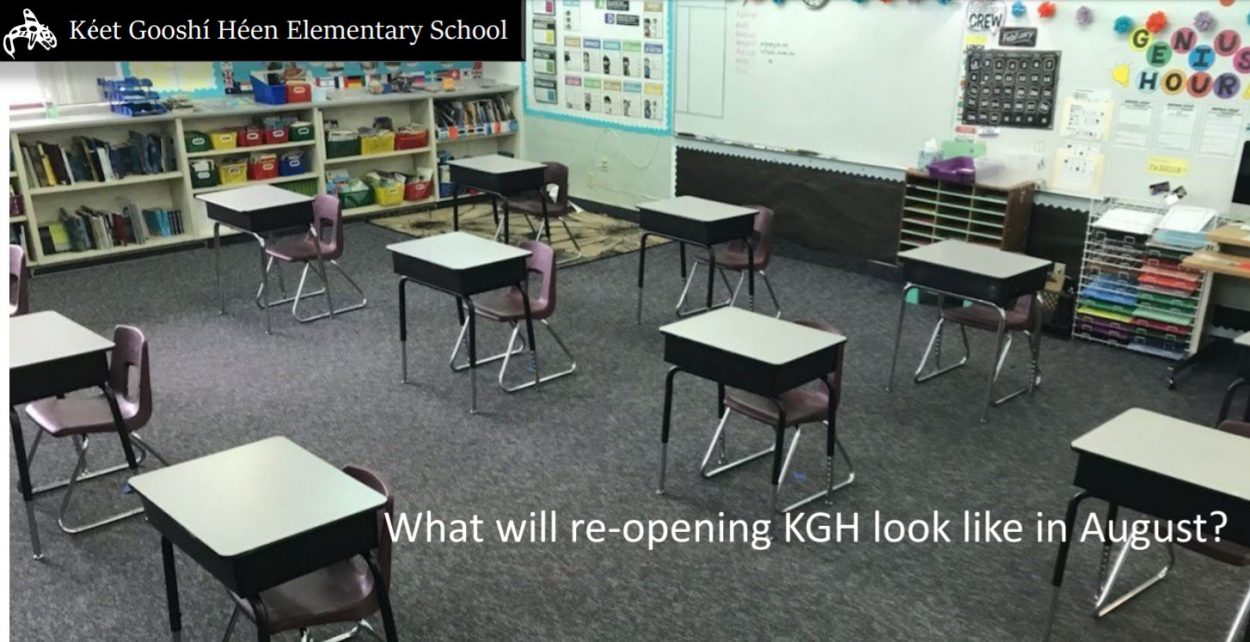
Schools in Sitka will open in August with a mixture of in-person and online classes, if the state approves the district’s “Smart Start” plan.
A task force of parents, educators, and administrators has been working almost since the end of school last spring, to develop strategies for Sitka’s five schools that keep as many students in the buildings as safely possible. Two major questions remain: How many students will come back? And how many teachers?
KCAW’s Robert Woolsey attended the most recent “Smart Start” task force meeting in Sitka, and filed this report.
See the entire Sitka Smart Start Task Force report from its meeting on Thursday, June 16, 2020.
If there’s any upside to having most of the summer to plan for school this fall, it’s that classes and teaching will be more tailored to the unusual circumstances of a pandemic. Last spring, you’ll remember, students in Alaska got a spring break that never ended, and there was a massive effort to transition all in-person teaching to online teaching — with mixed results.
The elementary levels, especially, were a struggle. Baranof parent and task force member Kristin Hames said her team wanted to see young children back in class.
“Kindergarteners and first-graders benefit most when they have hands-on experiences,” said Hames. “And also when they have personal interactions with peers. So really from day one our goal was to figure out how to make that happen, and how to do it safely.”
Hames said they wanted to create a “pod environment”: No more than 12-14 students in class led by team teachers, for four hours a day, five-days-a-week. Everyone — including students, faculty, and staff — will get a daily temperature screening, and be required to wear masks which will be provided by the school. Classrooms will be situated with desks no closer than six feet, lunch will be provided in class, and there will be no social interaction with other students outside of class.
Additionally, students will be doing much of their in-class work on iPads, using the Microsoft Teams platform, in the event there is an outbreak of coronavirus in the classroom and all students have to work from home again.

In all buildings the approach — if not the precise details — is the same: How to teach as many students as possible, at minimum risk.
Kate Mullin, a 7th grade Math teacher at Blatchley said the pod strategy — which at Blatchley they’re calling “cohorts” — was designed to prevent a mass exodus from school, in the event students or staff test positive for the coronavirus.
“Depending on whether somebody in the cohort gets the virus, then the whole school doesn’t necessarily have to shut down,” said Mullin. “Or at least that could provide a buffer.”
In the older grade levels like Blatchley and above, the task force recognizes that the physical hazard presented by the virus may outweigh the benefits of in-person academic instruction, and some parents may choose to have their kids learn from home exclusively. So every afternoon from 1:00 – 3:30 P.M. at Blatchley, students can attend their four core academic classes online, along with some electives.
The high school will be working along these lines as well — except under an A/B cohort system, where half the students are in school on alternate days. Task force member and teacher Tim Pike said it was inevitable that some students won’t attend in-person, which means that teachers will also be holding their classes twice daily — once in person, and once online.
“When a student cannot be there for reasons — such as, they have covid, or their family is in quarantine — we will provide five days of online instruction to go along with that,” said Pike. “How that looks, we’re not real sure yet.”
All of these plans assume medium risk from the COVID-19 virus. There are alternatives for low- and high-risk under each plan — everything from school that looks and feels like a normal school year, to an exclusive online environment.
And although the strategies focus on safe approaches to in-person learning, there is no consensus yet among teachers to what “safe” means.
Interim superintendent John Holst said that there was simply no way to eliminate risk entirely.
“We want everyone to be safe,” he said. “And one of our biggest struggles is going to be convincing teachers that it’s okay to be in the classroom. I know that’s going to happen. It’s just human nature.”
“I don’t know if ‘reluctance’ is the word I would use,” said Mike Vieira, president of the Sitka Education Association, the union representing teachers. “I would probably say there’s a certain population of teachers that feels a high level of anxiety about their safety in coming back to the classroom.”
Reached by KCAW by phone, Vieira complimented Holst and district education director Chris Voron on their collaborative approach to the Smart Start plan.
“And their message so far to this point has been: Anyone who feels they’re going to be in a position of compromised safety in returning to the classroom will be able to work with the district to have some type of alternative arrangement,” said Vieira.
The Sitka School Board has already delayed the opening of school by a week, to August 27, to give teachers more time to prepare for Smart Start. The district’s final plans must be submitted to the state Department of Education and Early Development by the end of July.






























